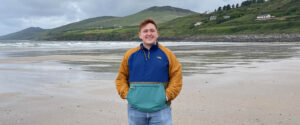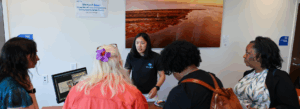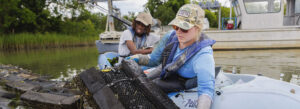Virginia Aquaculture Conference
discusses new technologies, opportunities
The Virginia Aquaculture Conference provided industry members with an opportunity to network and learn about relevant research and resources.
The conference, held Nov. 15-16 in Newport News, convened finfish and shellfish growers, hatchery operators, and others in the aquaculture to learn about industry issues and opportunities. The conference is hosted by the Marine Advisory Program (MAP) at the Virginia Institute of Marine Science (VIMS).
“It’s a nice opportunity for industry to not only learn—that’s one piece of it—but just be able to network and meet agency folks, meet researchers, and they can meet each other,” said Conference Organizer Karen Hudson, a shellfish aquaculture specialist for MAP.
Parallels between poultry agriculture and aquaculture
Poultry farming and aquaculture may not seem alike, but common themes overlap both industries—reducing disease mortality and improving growth through genetics and production methods.
Jim Perdue, chairman of Perdue Farms, drew on his experiences with his family business and background in aquaculture to make connections between aquaculture’s expansion and the poultry industry’s historic expansion.
“Back then, even inside chicken houses, mortalities of 20 to 40 percent were not uncommon,” Perdue said. “Chickens eating feed for 11 weeks and dying, that’s a major loss for your crop. Today, that number is 3 to 4 percent over a seven-week growth span.”
Perdue credited the National Poultry Improvement Plan and genetic analysis from universities for reducing mortality and improving growth so that the industry could expand.
Shellfish health and safety
Scientists from VIMS presented research highlights related to harmful algal blooms and water quality for growers and hatchery producers. Although there have been no reports of human illnesses from shellfish exposed to harmful algal blooms (HABs) in the Chesapeake Bay, HABs can negatively impact shellfish growth and health.
Students also presented rapid-fire research talks that covered topics like the effects of harmful algal blooms and oyster lease productivity.
A faculty panel discussed regional disease management efforts and potentially threatening oyster viruses, as well as how ocean acidification will affect water quality and larval oysters. A second panel discussed genetic research on improving hard clam genetics, triploid mortality, and the future of shellfish breeding.
Aquaponic systems, a combination of aquaculture and hydroponics, have emerged as a way to grow plants and fish in the same water system.
New technologies in finfish aquaculture and aquaponics
Aquaponic systems, a combination of aquaculture and hydroponics, have emerged as a way to grow plants and fish in the same water system. Helpful bacteria in the system play a key role in converting nutrients from the fish into forms the plants can use, but harmful bacteria like E. Coli must be managed to avoid food contamination.
During the finfish sessions, researchers from Virginia State University and Virginia Tech’s Seafood Agricultural Research and Extension Center (VSAREC) shared updates on research and extension programs. Topics included aquaponics, pond aquaculture, fish health, product quality, marketing, and sustainability.
VSAREC extension agents also discussed their efforts to document regulatory costs in order to make regulations less burdensome for the aquaculture industry. Surveys and interviews with growers helps show the costs of regulation for aquaculture farms. In the Western United States, regulations cost salmonid growers roughly $11.7 million per year. Right now, VSAREC is conducting surveys to document the cost of regulations for East Coast Shellfish growers.
Opportunities for expansion
Roughly 140,000 acres of the public Baylor grounds are unproductive and unsuitable for oyster replenishment, according to one study. During the conference, a panel of speakers from VIMS, the Virginia Coastal Policy Center at William & Mary Law School, and the Virginia Marine Resources Commission discussed alternative ways these unproductive grounds could be used for aquaculture.
These grounds have opportunities for both shallow- and deep-water aquaculture, according to Marcia Berman, a scientist at the Center for Coastal Resources Management at VIMS. Angela King, assistant director of VCPC, explained the two main policy paths for adjusting public grounds: redefining the boundaries, or expanding the allowable uses within the current boundaries.
“Where’s the expansion?” VIMS Professor Roger Mann asked. “Expansion is with everyone who’s sitting here today.”
Takeaways:
- The aquaculture conference connects the aquaculture industry with research that’s relevant to their operations.
- The conference, held every other year, provides growers with an opportunity to network with other industry members, suppliers, scientists, and agency staff.
- The 2019 conference presentations discussed topics such as water quality, opportunities for industry growth, aquaponics, and marketing.
Photos and video by Aileen Devlin | Virginia Sea Grant
Story by Madeleine Jepsen | Virginia Sea Grant
Published July 9, 2021.
Rapid-fire Research Highlights
-
In hatcheries, good water flow, water changes, and frequent larval drops can greatly reduce mortality from Karlodinium veneficum.
-
Understanding the genetics of hard clams gives researchers insights about how farm-raised clams compare to wild clams and how much clam genes can vary by region.
-
Oysters can experience delayed biological effects from exposure to two harmful algal bloom species found in the lower Chesapeake Bay.
-
Low pH can hinder growth in larval oysters, and environmental conditions experienced by juvenile oysters can affect their performance.
-
Intensive oyster aquaculture is rebounding, but there is strong evidence of social and regulatory constraints.
-
Low levels of toxins have been detected even when no harmful algal blooms (HABs) were happening, so continual monitoring can be important to prevent HAB-related illness in humans.
Poultry farming and aquaculture may not seem alike, but common themes overlap both industries—reducing disease mortality and improving growth through genetics and production methods.





